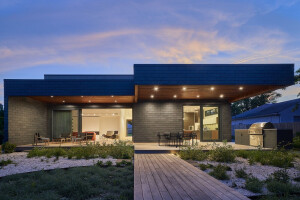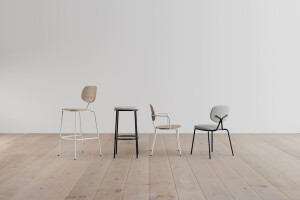On a beautiful, panoramic, steep plot next to the forest in Budapest a three-storey family house built in the nineties became obsolete.

At the beginning of the nineties, large family houses grew like mushrooms in the newly parceled suburbs of Budapest. In thirty years, these areas have been transformed, the value of real estate has multiplied, while the hillsides became overbuilt and confusing. Our aim was to merge the building into the nature with its dark colours and natural materials compensating the chaotic suburban cityscape.

The family house with poor construction quality is worth a renovation. Transforming the existing building, minimizing construction waste are less spectacular but more important tools of sustainability, despite the more complex and challenging design and construction.

Our task was to turn this family house into a generous, modern villa. We used architectural tools such as a four-column, portico-like terrace support, a bridge-like arrival, or a staircase drawn along an arched wall leading to a living area with slant ceilings.

For the transformation, we removed the entire roof level and added a new, spacious staircase between the bedroom and the living space. The former loft rooms changed to a two-car garage and a panoramic, transparent living area with a large covered terrace. The en-suite bedrooms with wardrobes on the middle level are attached to the walkway looking to the nature. On the lower, yet still panoramic level, we completed the semi-finished pool, opened both ends towards the garden, and added a sauna and a shower.

The solid mass of the villa got a dark clinker cladding, which was chosen for its elegant appearance and the connection with the natural environment. It was also important to create a restrained house on the hillside where buildings confuse the original landscape. The clinker tiles in the standing format do not mimic the tectonics of the built brick walls, but due to the binding method they give a nice turnaround on corners, its unusual shingle-like behavior gives further associations.

The new penthouse level is created under an exposed concrete roof with a planed board formwork that emerges from the brick skin and connects the exterior and interior spaces, supported by an asymmetrically shifted column row as a quote of the classical porticos.

Like the two-facedness of classic modern villas, a single-storey, enclosed mass opens up from the street. The new bridge-like entrance is not only convenient but also dramaturgically important. From here, a corner of the panorama emerges. Entering the covered foreground, the view is revealed under the raw concrete roof rising towards the city. Ash wood built-in furniture divides the interior, which opens to the covered terrace with a wooden glass wall and sliding doors. The soft-raw materials line the villa home, which is closed from the street but unfolds towards the seemingly distant city.








































